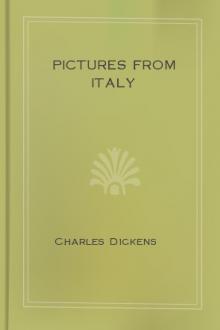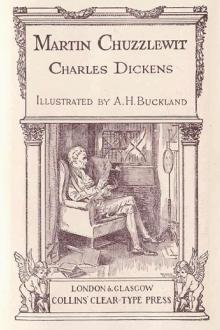Travels Through France And Italy by Tobias Smollett (beautiful books to read .txt) 📖

- Author: Tobias Smollett
Book online «Travels Through France And Italy by Tobias Smollett (beautiful books to read .txt) 📖». Author Tobias Smollett
The Ingenious Editor Of Fingal, Who Seems To Think That Caracalla
Is No Other Than The Celtic Word, Adapted To The Pronunciation Of
The Romans: But The Truth Is, Caracalla Was The Name Of A Gaulish
Vestment, Which This Prince Affected To Wear; And Hence He
Derived That Surname. The Caracuyl Of The Britons, Is The Same As
The Upodra Idon Of The Greeks, Which Homer Has So Often Applied
To His Scolding Heroes. I Like The Bacchanalian, Chiefly For The
Fine Drapery. The Wind, Occasioned By Her Motion, Seems To Have
Swelled And Raised It From The Parts Of The Body Which It Covers.
There Is Another Gay Bacchanalian, In The Attitude Of Dancing,
Crowned With Ivy, Holding In Her Right Hand A Bunch Of Grapes,
And In Her Left The Thyrsus. The Head Of The Celebrated Flora Is
Very Beautiful: The Groupe Of Cupid And Psyche, However, Did Not
Give Me All The Pleasure I Expected From It.
Of All The Marbles That Appear In The Open Gallery, The Following
Are Those I Most Admire. Leda With The Swan; As For Jupiter, In
This Transformation, He Has Much The Appearance Of A Goose. I
Have Not Seen Any Thing Tamer; But The Sculptor Has Admirably
Shewn His Art In Representing Leda's Hand Partly Hid Among The
Feathers, Which Are So Lightly Touched Off, That The Very Shape
Of The Fingers Are Seen Underneath. The Statue Of A Youth,
Supposed To Be Ganymede, Is Compared By The Connoisseurs To The
Celebrated Venus, And As Far As I Can Judge, Not Without Reason:
It Is However, Rather Agreeable Than Striking, And Will Please A
Connoisseur Much More Than A Common Spectator. I Know Not Whether
It Is My Regard To The Faculty That Inhances The Value Of The
Part 7 Letter 28 ( Nice, February 5, 1765.) Pg 230Noted Esculapius, Who Appears With A Venerable Beard Of Delicate
Workmanship. He Is Larger Than The Life, Cloathed In A
Magnificent Pallium, His Left Arm Resting On A Knotted Staff,
Round Which The Snake Is Twined According To Ovid.
Hunc Modo Serpentem Baculum Qui Nexibus Ambit
Perspice--
Behold The Snake His Mystic Rod Intwine.
He Has In His Hand The Fascia Herbarum, And The Crepidae On His
Feet. There Is A Wild-Boar Represented Lying On One Side, Which I
Admire As A Master-Piece. The Savageness Of His Appearance Is
Finely Contrasted With The Case And Indolence Of The Attitude.
Were I To Meet With A Living Boar Lying With The Same Expression,
I Should Be Tempted To Stroke His Bristles. Here Is An Elegant
Bust Of Antinous, The Favourite Of Adrian; And A Beautiful Head
Of Alexander The Great, Turned On One Side, With An Expression Of
Languishment And Anxiety In His Countenance. The Virtuosi Are Not
Agreed About The Circumstance In Which He Is Represented; Whether
Fainting With The Loss Of Blood Which He Suffered In His
Adventure At Oxydrace; Or Languishing With The Fever Contracted
By Bathing In The Cydnus; Or Finally Complaining To His Father
Jove, That There Were No Other Worlds For Him To Conquer. The
Kneeling Narcissus Is A Striking Figure, And The Expression
Admirable. The Two Bacchi Are Perfectly Well Executed; But (To My
Shame Be It Spoken) I Prefer To The Antique That Which Is The
Work Of Michael Angelo Buonaroti, Concerning Which The Story Is
Told Which You Well Know. The Artist Having Been Blamed By Some
Pretended Connoisseurs, For Not Imitating The Manner Of The
Ancients, Is Said To Have Privately Finished This Bacchus, And
Buried It, After Having Broke Off An Arm, Which He Kept As A
Voucher. The Statue, Being Dug Up By Accident, Was Allowed By The
Best Judges, To Be A Perfect Antique; Upon Which Buonaroti
Produced The Arm, And Claimed His Own Work. Bianchi Looks Upon
This As A Fable; But Owns That Vasari Tells Such Another Of A
Child Cut In Marble By The Same Artist, Which Being Carried To
Rome, And Kept For Some Time Under Ground, Was Dug Up As An
Antique, And Sold For A Great Deal Of Money. I Was Likewise
Attracted By The Morpheus In Touchstone, Which Is Described By
Addison, Who, By The Bye, Notwithstanding All His Taste, Has Been
Convicted By Bianchi Of Several Gross Blunders In His Account Of
This Gallery.
With Respect To The Famous Venus Pontia, Commonly Called De
Medicis, Which Was Found At Tivoli, And Is Kept In A Separate
Part 7 Letter 28 ( Nice, February 5, 1765.) Pg 231Apartment Called The Tribuna, I Believe I Ought To Be Intirely
Silent, Or At Least Conceal My Real Sentiments, Which Will
Otherwise Appear Equally Absurd And Presumptuous. It Must Be Want
Of Taste That Prevents My Feeling That Enthusiastic Admiration
With Which Others Are Inspired At Sight Of This Statue: A Statue
Which In Reputation Equals That Of Cupid By Praxiteles, Which
Brought Such A Concourse Of Strangers Of Old To The Little Town
Of Thespiae. I Cannot Help Thinking That There Is No Beauty In
The Features Of Venus; And That The Attitude Is Aukward And Out
Of Character. It Is A Bad Plea To Urge That The Antients And We
Differ In The Ideas Of Beauty. We Know The Contrary, From Their
Medals, Busts, And Historians. Without All Doubt, The Limbs And
Proportions Of This Statue Are Elegantly Formed, And Accurately
Designed, According To The Nicest Rules Of Symmetry And
Proportion; And The Back Parts Especially Are Executed So
Happily, As To Excite The Admiration Of The Most Indifferent
Spectator. One Cannot Help Thinking It Is The Very Venus Of
Cnidos By Praxiteles, Which Lucian Describes. "Hercle Quanta
Dorsi Concinnitas! Ut Exuberantes Lumbi Amplexantes Manus
Implent! Quam Scite Circumductae Clunium Pulpae In Se
Rotundantur, Neque Tenues Nimis Ipsis Ossibus Adstrictae, Neque
In Immensam Effusae Pinguedinem!" That The Statue Thus Described
Was Not The Venus De Medicis, Would Appear From The Greek
Inscription On The Base, Kleomenis Appollodoroi Athinaios
Epoesei. Cleomenes Filius Apollodori Fecit; Did We Not Know That
This Inscription Is Counted Spurious, And That Instead Of
Epoesei, It Should Be Epoiese. This, However, Is But A Frivolous
Objection, As We Have Seen Many Inscriptions Undoubtedly Antique,
In Which The Orthography Is False, Either From The Ignorance Or
Carelessness Of The Sculptor. Others Suppose, Not Without Reason,
That This Statue Is A Representation Of The Famous Phryne, The
Courtesan Of Athens, Who At The Celebration Of The Eleusinian
Games, Exhibited Herself Coming Out Of The Bath, Naked, To The
Eyes Of The Whole Athenian People. I Was Much Pleased With The
Dancing Faun; And Still Better With The Lotti, Or Wrestlers, The
Attitudes Of Which Are Beautifully Contrived To Shew The
Different Turns Of The Limbs, And The Swelling Of The Muscles:
But, What Pleased Me Best Of All The Statues In The Tribuna Was
The Arrotino, Commonly Called The Whetter, And Generally Supposed
To Represent A Slave, Who In The Act Of Whetting A Knife,
Overhears The Conspiracy Of Catiline. You Know He Is Represented
On One Knee; And Certain It Is, I Never Saw Such An Expression Of
Anxious Attention, As Appears In His Countenance. But It Is Not
Mingled With Any Marks Of Surprise, Such As Could Not Fail To Lay
Hold On A Man Who Overhears By Accident A Conspiracy Against The
State. The Marquis De Maffei Has Justly Observed That Sallust, In
His Very Circumstantial Detail Of That Conspiracy, Makes No
Mention Of Any Such Discovery. Neither Does It Appear That The
Figure Is In The Act Of Whetting, The Stone Which He Holds In One
Hand Being Rough And Unequal No Ways Resembling A Whetstone.
Others Alledge It Represents Milico, The Freedman Of Scaevinus,
Who Conspired Against The Life Of Nero, And Gave His Poignard To
Be Whetted To Milico, Who Presented It To The Emperor, With An
Account Of The Conspiracy: But The Attitude And Expression Will
Part 7 Letter 28 ( Nice, February 5, 1765.) Pg 232No Means Admit Of This Interpretation. Bianchi, [This
Antiquarian Is Now Imprisoned For Life, For Having Robbed The
Gallery And Then Set It On Fire.] Who Shows The Gallery, Thinks
The Statue Represents The Augur Attius Navius, Who Cut A Stone
With A Knife, At The Command Of Tarquinius Priscus. This
Conjecture Seems To Be Confirmed By A Medallion Of Antoninus
Pius, Inserted By Vaillant Among His Numismata Prestantiora, On
Which Is Delineated Nearly Such A Figure As This In Question,
With The Following Legend. "Attius Navius Genuflexus Ante
Tarquinium Priscum Cotem Cultro Discidit." He Owns Indeed That In
The Statue, The Augur Is Not Distinguished Either By His Habit Or
Emblems; And He Might Have Added, Neither Is The Stone A Cotes.
For My Own Part, I Think Neither Of These Three Opinions Is
Satisfactory, Though The Last Is Very Ingenious. Perhaps The
Figure Allude To A Private Incident, Which Never Was Recorded In
Any History. Among The Great Number Of Pictures In This Tribuna,
I Was Most Charmed With The Venus By Titian, Which Has A
Sweetness Of Expression And Tenderness Of Colouring, Not To Be
Described. In This Apartment, They Reckon Three Hundred Pieces,
The Greatest Part By The Best Masters, Particularly By Raphael,
In The Three Manners By Which He Distinguished Himself At
Different Periods Of His Life. As For The Celebrated Statue Of
The Hermaphrodite, Which We Find In Another Room, I Give The
Sculptor Credit For His Ingenuity In Mingling The Sexes In The
Composition; But It Is, At Best, No Other Than A Monster In
Nature, Which I Never Had Any Pleasure In Viewing: Nor, Indeed,
Do I Think There Was Much Talent Required In Representing A
Figure With The Head And Breasts Of A Woman, And All The Other
Parts Of The Body Masculine. There Is Such A Profusion Of
Curiosities In This Celebrated Musaeum; Statues, Busts, Pictures,
Medals, Tables Inlaid In The Way Of Marquetry, Cabinets Adorned
With Precious Stones, Jewels Of All Sorts, Mathematical
Instruments, Antient Arms And Military Machines, That The
Imagination Is Bewildered, And A Stranger Of A Visionary Turn,
Would Be Apt To Fancy Himself In A Palace Of The Fairies, Raised
And Adorned By The Power Of Inchantment.
In One Of The Detached Apartments, I Saw The Antependium Of The
Altar, Designed For The Famous Chapel Of St. Lorenzo. It Is A
Curious Piece Of Architecture, Inlaid With Coloured Marble And
Precious Stones, So As To Represent An Infinite Variety Of
Natural Objects. It Is Adorned With Some Crystal Pillars, With
Capitals Of Beaten Gold. The Second Story Of The Building Is
Occupied By A Great Number Of Artists Employed In This Very
Curious





Comments (0)